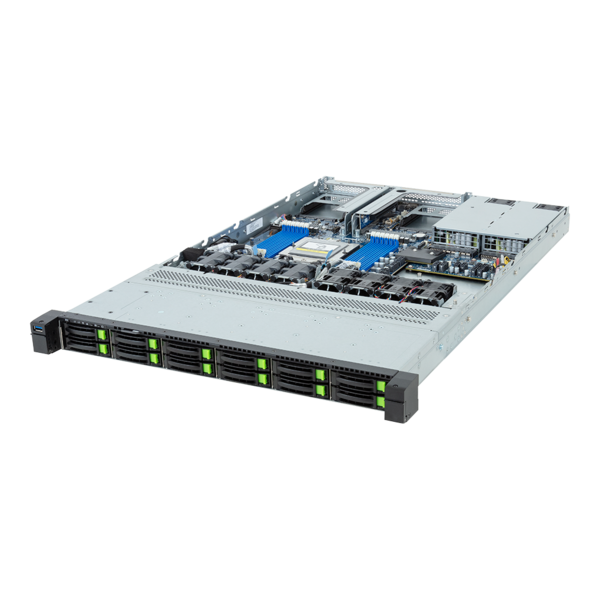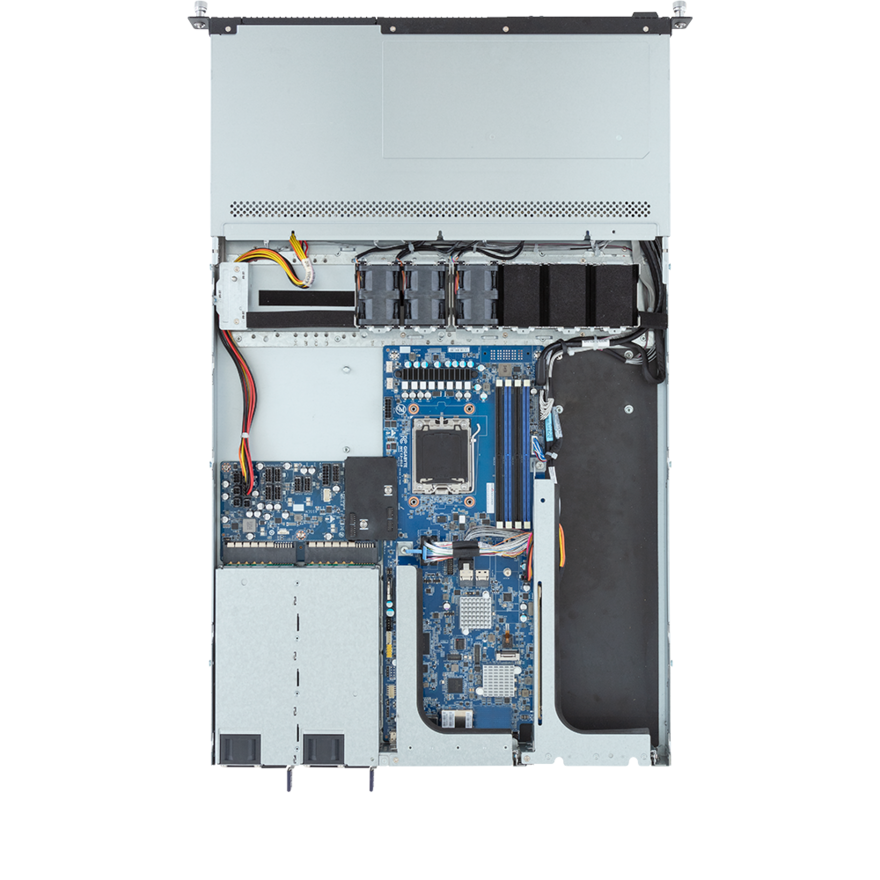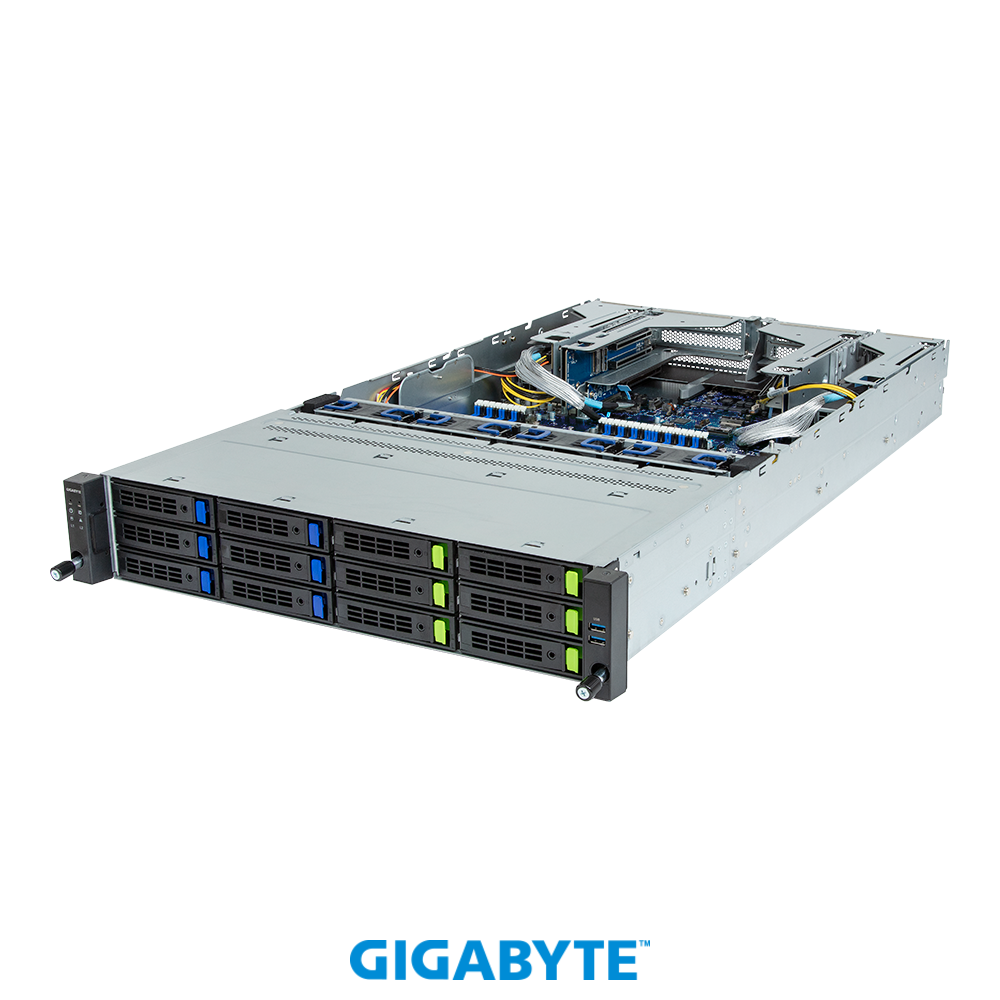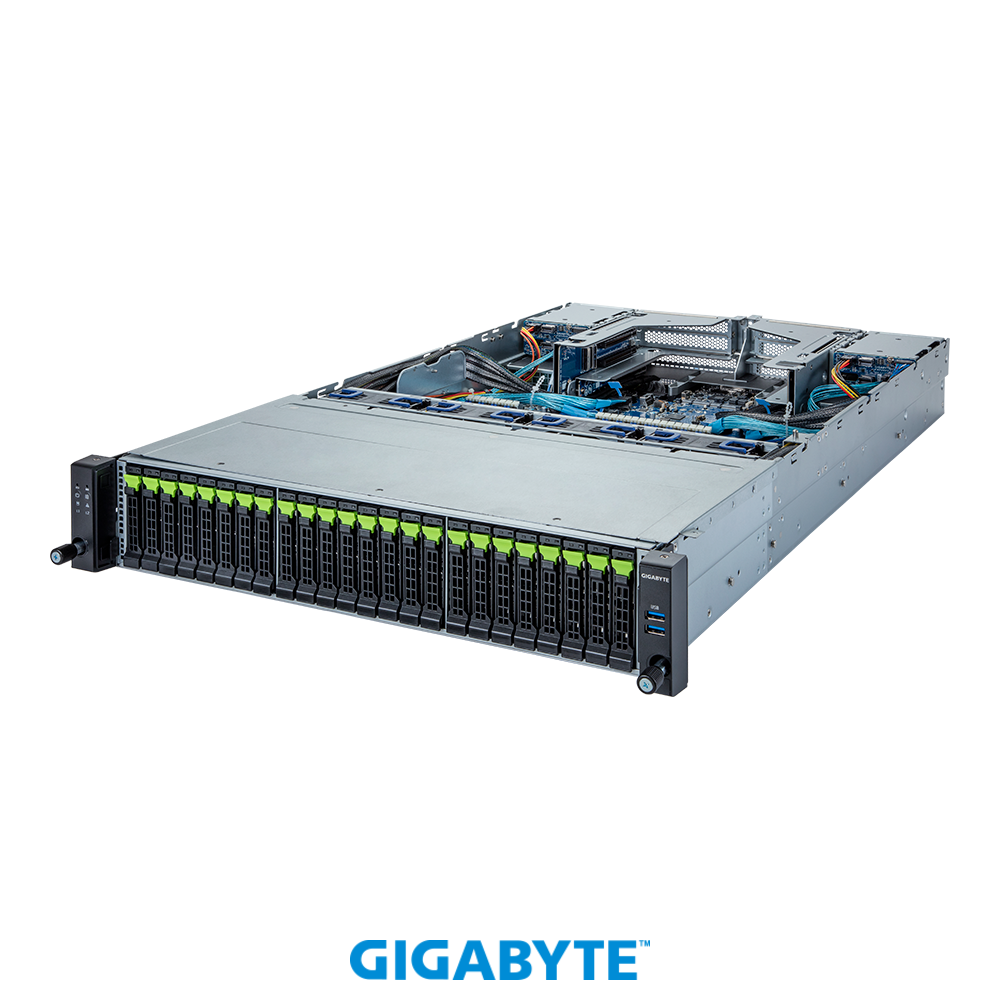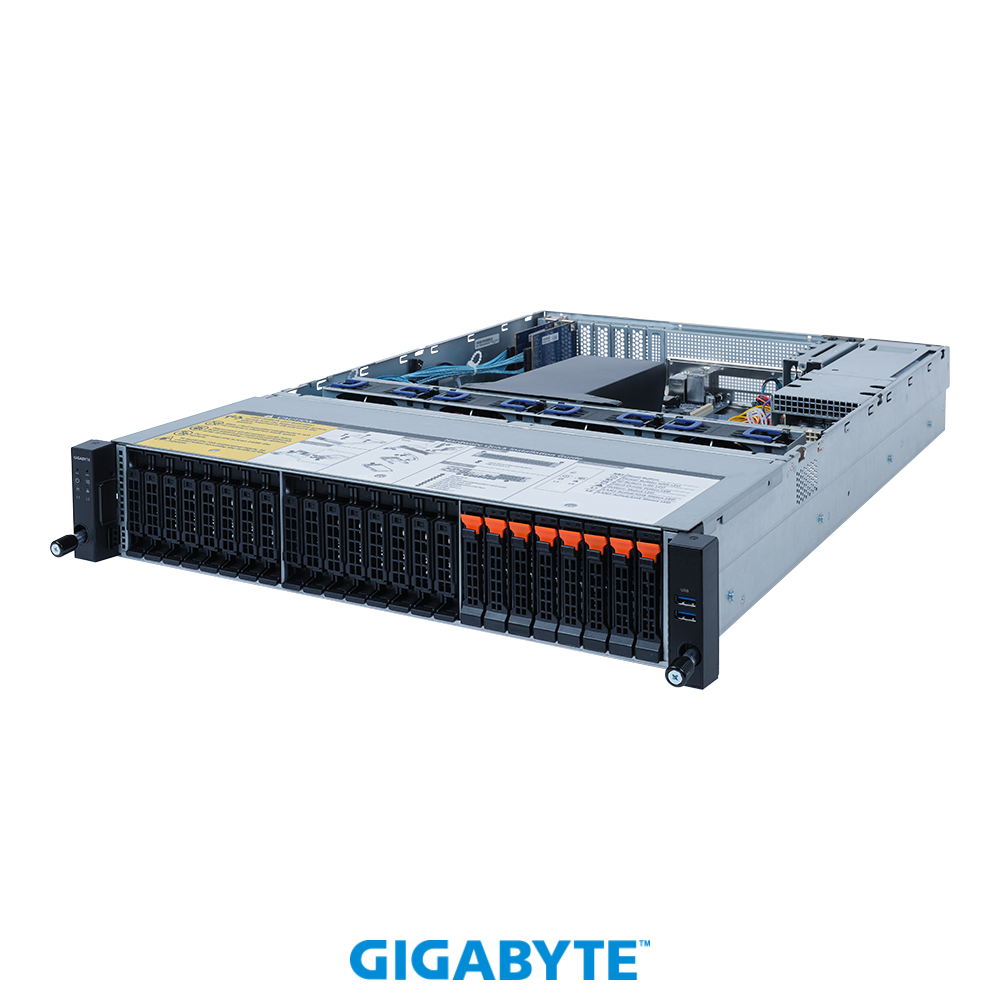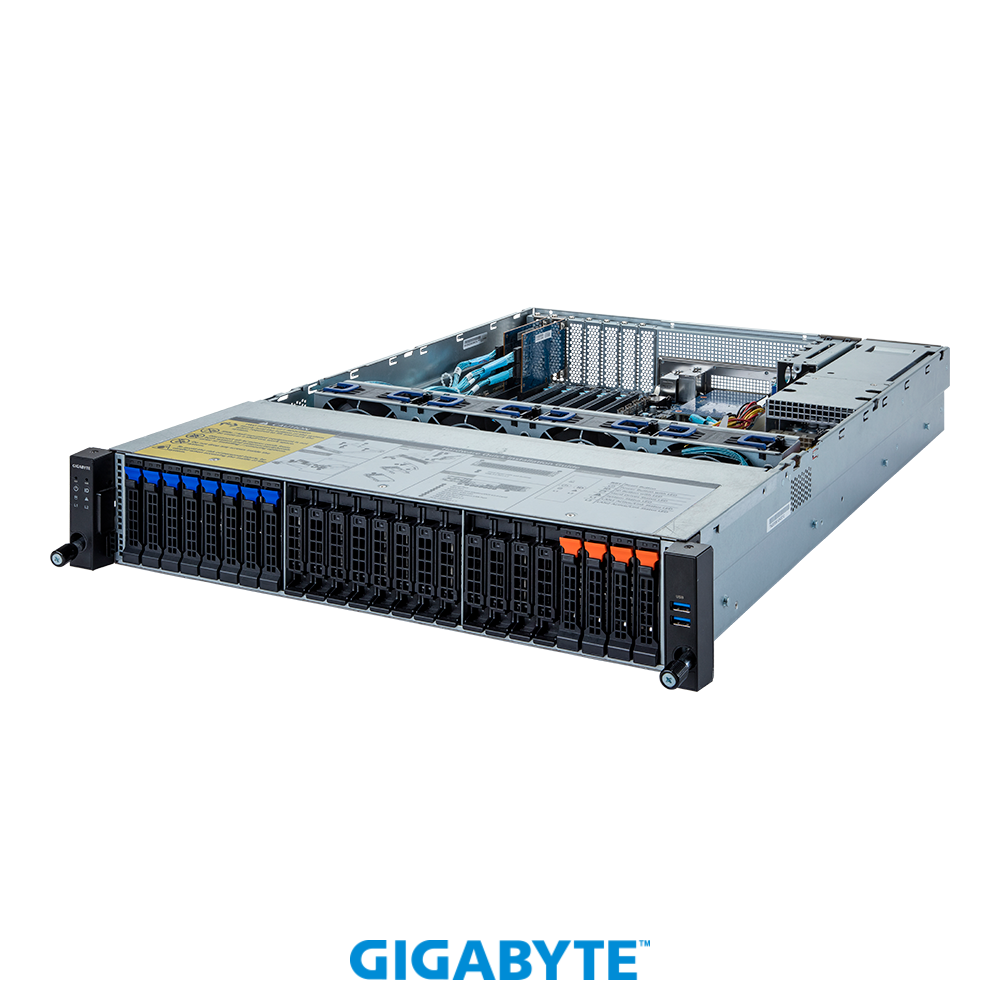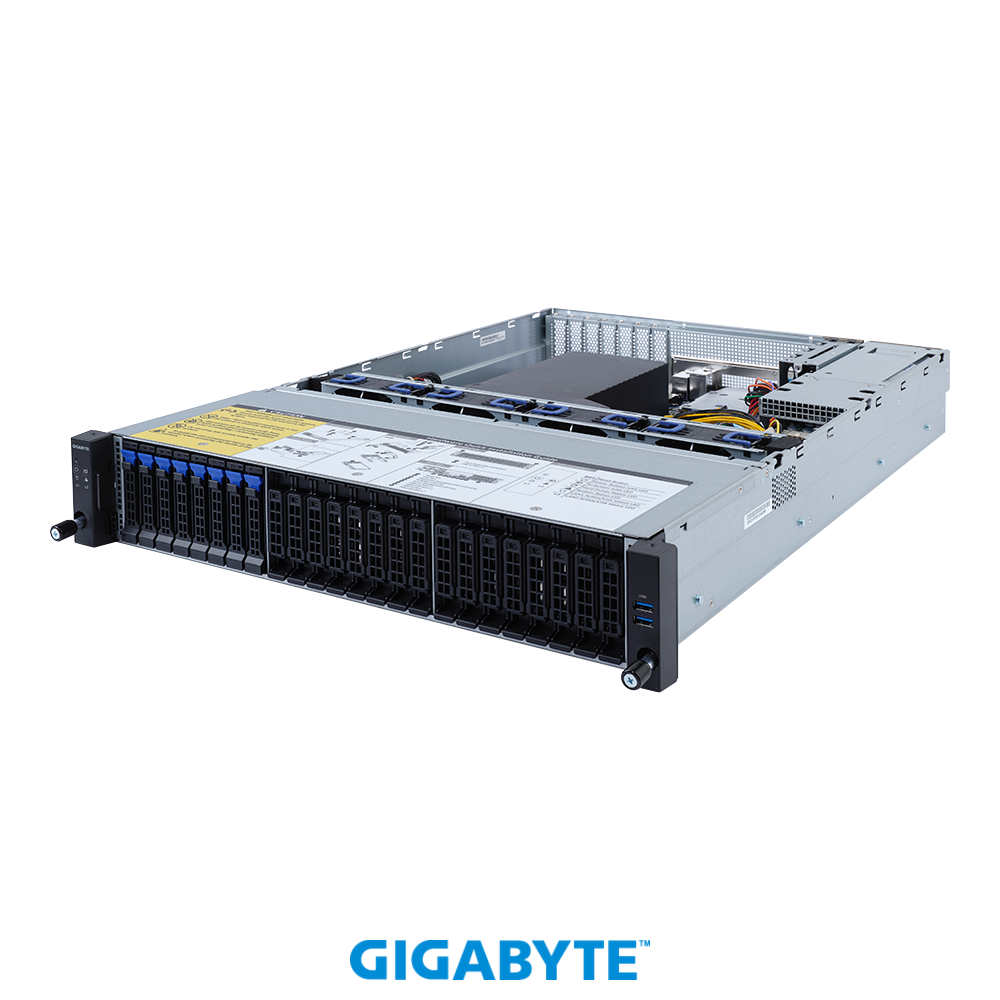GIGABYTE R272-Z31 (rev. 100)
Application: Network Server
- AMD EPYC™ 7002 Series processors
- Single processor, 7nm technology
- 8-Channel RDIMM/LRDIMM DDR4, 16 x DIMMs
- 2 x 1Gb/s LAN ports (Intel® I350-AM2)
- 1 x Dedicated management port
- Onboard 12Gb/s SAS expander
- 24 x 2.5" SATA/SAS hot-swappable bays
- 2 x 2.5" SATA/SAS hot-swappable bays on rear side
- 2 x M.2 slots with PCIe Gen3 x4 interface
- 4 x LP PCIe Gen4 x16 and x8 slots
- 2 x LP PCIe Gen3 x16 and x8 slots
- 1 x OCP 2.0 Gen3 x16 mezzanine slot
- Aspeed® AST2500 remote management controller
- Dual 800W 80 PLUS Platinum redundant power supply
GIGABYTE R272-Z31 (rev. 100)
AMD EPYC™ 7002 Series Processor (Rome)
The next generation of AMD EPYC has arrived, providing incredible compute, IO and bandwidth capability – designed to meet the huge demand for more compute in big data analytics, HPC and cloud computing.
- Built on 7nm advanced process technology, allowing for denser compute capabilities with lower power consumption
- Up to 64 core per CPU, built using Zen 2 high performance cores and AMD’s innovative chiplet architecture
- Supporting PCIe Gen 4.0 with a bandwidth of up to 64GB/s, twice of PCIe Gen 3.0
- Embedded security protection to help defend your CPU, applications, and data

.jpg)
R272-Z31 Product Overview
.png)
GIGABYTE Management Console
GIGABYTE server utilizes the AMI MegaRAC SP-X solution for BMC server management, has a browser-based graphical user interface, and is feature-rich and easy to use.
- RESTful API support includes the latest DMTF standard of Redfish. Allows integration with 3rd party applications for server management
- Including HTML5 based iKVM remote management client, no need to purchase other additional licenses
- Detailed FRU information from SMBIOS
- 10 to 30 seconds pre-event automatic recording function
- SAS / RAID controller monitoring function
GIGABYTE Server Management (GSM)
.png)
GIGABYTE Server Management (GSM) is GIGABYTE’s proprietary multiple server remote management software platform, available as a free download from each GIGABYTE server product page. GSM is compatible with either IPMI or Redfish (RESTful API) connection interfaces, and comprises the following sub-programs:
- GSM Server, a software program with an easy to use browser-based GUI to enable global remote monitoring and management of multiple GIGABYTE servers via each server node’s BMC.
- GSM CLI, a command-line interface program to enable global remote monitoring and management of multiple GIGABYTE servers via each server node’s BMC.
- GSM Agent, a software program installed locally on each GIGABYTE server node that retrieves additional node information (CPU/Mem/HDD/PCI/…) from the OS and passes it to the BMC. This information can then be utilized by GSM Server or GSM CLI.
- GSM Mobile, a remote server management mobile APP, available for both Android and iOS.
- GSM Plugin, a plugin that allows the user to manage and monitor GIGABYTE server nodes within VMware’s vCenter.
Intuitive & Informative User Interface
Starting from the GSM Server dashboard, the user can clearly understand the status of each node in the IT environment, including:
- Node connection status (system is online/offline)
- Node hardware sensor status (to detect hardware anomalies). Sensors measure voltage, fan speed and temperature
- Node usage rate status (allowing you to timely allocate more resources when they are needed), including:
- Power consumption
- Disk/RAID usage information
- Memory usage rate
- CPU usage rate
- Network card / PCI information
The user can also perform various management functions, including:
- Node remote access
- Power on / off / reset
- Launch iKVM
- Reboot BMC / BMC Account Configuration
- Network Configuration
- IPv4/IPv6 setting
- Alert Management
- SNMP trap setting
- Platform events filters
- Forwarding alerts by email
- BMC / BIOS / CPLD Update
- Power Consumption Limit Setting
- Group Management
- Create groups of nodes for BMC / BIOS update or manage power consumption settings
GSM Mobile for iOS and Android
A GSM Mobile app is available for download for both iOS and Android mobile phones for remote server management on the go.
Download GSM APP for iOS
Download GSM APP for Android
.png)
Management through VMware vCenter
A GSM Plugin is available for VMware’s vCenter, allowing the user to perform remote monitoring and management of GIGABYTE server nodes without having to switch to a separate software platform.
.png)
R272-Z31 System Block Diagram
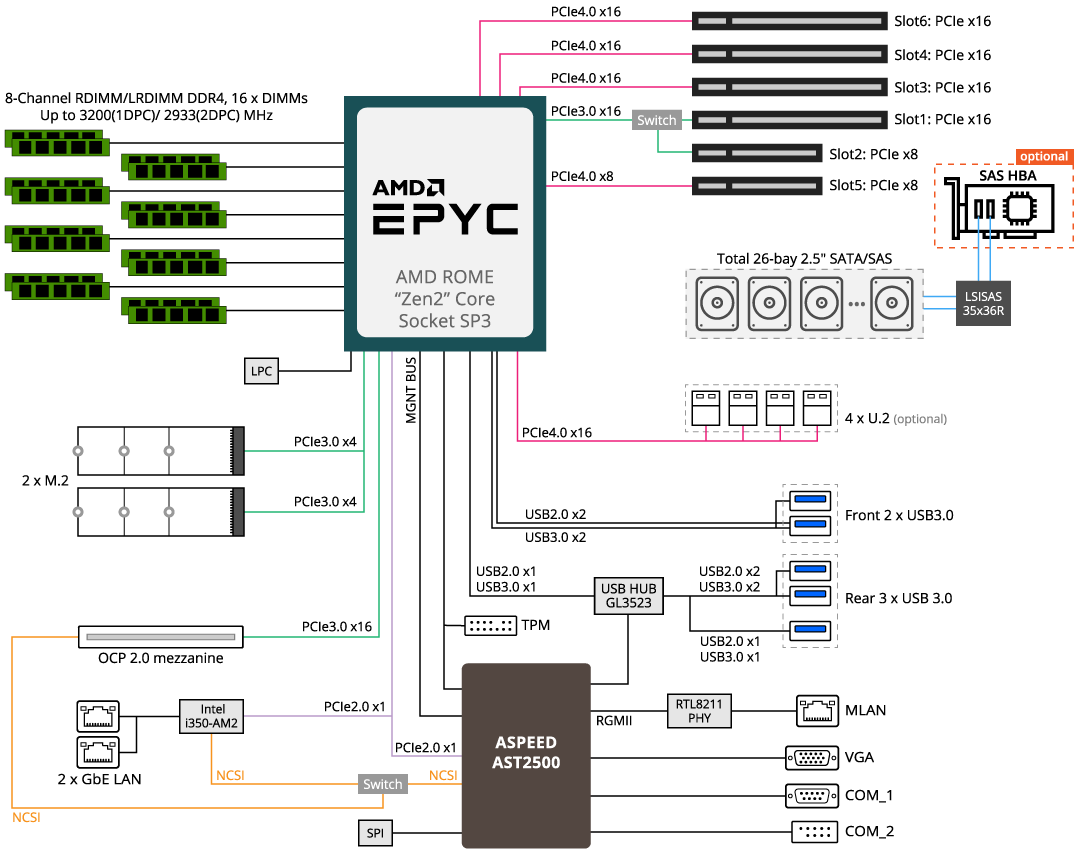
PCIe Gen 4.0 Ready
AMD EPYC Rome is ready to support PCIe Gen 4.0 with a bandwidth of 64GB/s, twice that of PCIe Gen 3.0. This doubles the bandwidth available from the CPU to peripheral devices such as graphics cards, storage devices and high speed network cards. GIGABYTE’s AMD EPYC 7002 Series server platforms are ready to be used with a new generation of PCIe Gen 4.0 devices such as AMD’s Radeon MI50 GPGPU.
* The PCIe 4.0 standard supports a 16 GT/s bit rate, (roughly 2GB/s per single lane) as opposed to 8GT/s bit rate for PCIe 3.0 (1GB/s).
.png)
Higher Memory Speed
AMD EPYC’s Rome 7002 Series processors feature faster 8 channel DDR4 memory lanes, supporting RDIMM or LRDIMM memory modules with a speed of up to 3200MHz (1 DIMM per channel)
.png)
Get the Memory Performance Edge
3200Mhz Even at 2 DIMMS Per Channel
On previous AMD server platforms, memory speed has been automatically downgraded by design when a user installed two DIMMs per channel. GIGABYTE has now developed a unique solution to overcome this performance downgrade headache: with our new 2nd Generation AMD EPYC 7002 Series server platforms, maximum memory speed (3200Mhz) is now supported even when using 2 DIMMS per channel*. GIGABYTE’s server platforms give you the performance edge, with more memory capacity at faster speeds than competing solutions!
* Enabled via BIOS setting (“UMC Common Options” “DDR4 Common Options” Configure “Enforce POR” setting). Please follow product QVL. Please consult your GIGABYTE sales or technical representative for more information.
.png)
More M.2 Storage
GIGABYTE’s AMD EPYC 7002 Series server platforms feature more M.2 drive capacity for ultra-fast NVMe storage – both onboard M.2 slots and extra capacity via optional riser cards.
.jpg)
Max TDP Support
GIGABYTE’s AMD EPYC server platforms come ready to support the full list of AMD EPYC 7002 Series processors: up to 225W (standard TDP) / 280W (cTDP)
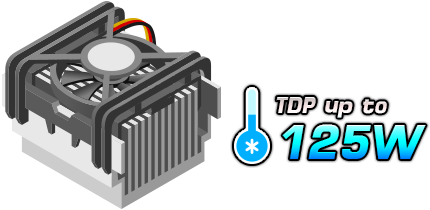
Data Security
TPM 2.0 Module
GIGABYTE’s AMD EPYC Server is designed to support Trusted Platform Modules (TPM - discrete cryptographic on-board processors).
.png)
Carefully Selected Components
GIGABYTE’s passive components are carefully selected to guarantee a stable operating environment and allow the processors and the memory to deliver their maximum performance. GIGABYTE’s server motherboards are built with long lasting components for a high degree of reliability and durability.
.png)
Design Features for Easy Maintenance
GIGABYTE’s AMD EPYC 7002 Series server platforms contain many tool less design features for easy installation, maintenance and removal – never worry about forgetting your toolbox or losing a screw again!
Tool-less Rail Kits
Rail kits attach to the side of the server chassis via clipping mechanism.
Tool-less 2.5” & 3.5” Drive Bays
Clipping mechanism secures the drive in place. Install or replace a new drive in seconds.

Efficient, Reliable Power Supply
GIGABYTE’s AMD EPYC 7002 Series server are designed to guarantee high conversion efficiency regardless of load. Redundant 80 Plus ‘Titanium’ or ‘Platinum’ PSUs, combined with GIGABYTE’s precision engineering, translates to super efficient power usage which maximizes the system’s power : performance ratio and reduces OPEX for the user.
.png)
Intelligent Power Management Features
Cold Redundancy
To take advantage of the fact that a PSU will run at greater power efficiency with a higher loading, GIGABYTE has introduced a power management feature called Cold Redundancy for servers with dual PSU. When the total system loading falls lower than 40%, the system will automatically place one PSU into standby mode, enabling the other PSU to take over the greater load. This can enable total system power efficiency savings of up to 10%.
.png)
System Power Efficiency
SCMP (Smart Crises Management / Protection)
SCMP is a GIGABYTE patented feature that will automatically force the system’s CPU to enter ULFM (ultra-low frequency mode for minimum power consumption) when the BMC is alerted to a PSU fault or error (such as power loss, power surge, overheating or a fan problem). This feature will prevent shutdown in systems with less than 1 + 1 PSU redundancy when one PSU is lost.

System Loading Curve
Dynamic Fan Speed Control
GIGABYTE servers are enabled with dynamic fan speed adjustment. Individual fan speed will be automatically adjusted according to the system’s current temperature (according to CPU, DIMM, M.2, HDD, GPU temperature sensors), to achieve the best cooling and power efficiency. When the BMC detects a temperature change, fan speed will be automatically adjusted accordingly. Fan speed profiles may also be manually created and edited* when necessary according to the user’s custom requirements.
* Enabled on selected models & performed through BMC console management GUI
.png)
Environmental Compliance
GIGABYTE maintains its commitment to green products, and adheres to the latest RoHS regulations (in effect July 2017).
.png)
VMware Ready
The R272-Z31 is validated for and fully compatible with VMware ESXi Hypervisor.
VMware Technology Alliance Partner
Being a member of VMware's Technology Alliance Partner (TAP) program enables GIGABYTE to rapidly develop and certify joint solutions or go-to-market products that leverage VMware virtualization and cloud solutions, enabling our customers to modernize their data centers and implement IT infrastructure and application services with speed, agility, and cost optimization.
Enquire with your GIGABYTE sales representative for more information about combining or integrating this server product with VMware solutions.
.png)
#vdo, #vdo-distributor, #máy-chủ-gigabyte, #server-gigabyte-R283-Z92-rev-AAE2, #Máy-chủ-Gigabyte-R283-Z92-rev-AAE2, #gigabyte-R283-Z92-rev-AAE2, #R283-Z92-rev-AAE2
VDO Distributor - Nhà phân phối hạ tầng Công nghệ thông tin & Viễn thông hàng đầu Việt Nam
Website: dis.vdo.com.vn
1900 0366
- Liên hệ tổng đài hoặc số điện thoại chi nhánh theo khu vực để nhận được tư vấn:
- Hà Nội: 024 7305 6666
- TP.HCM: 028 7308 6666
- Đà Nẵng: 093 610 8858






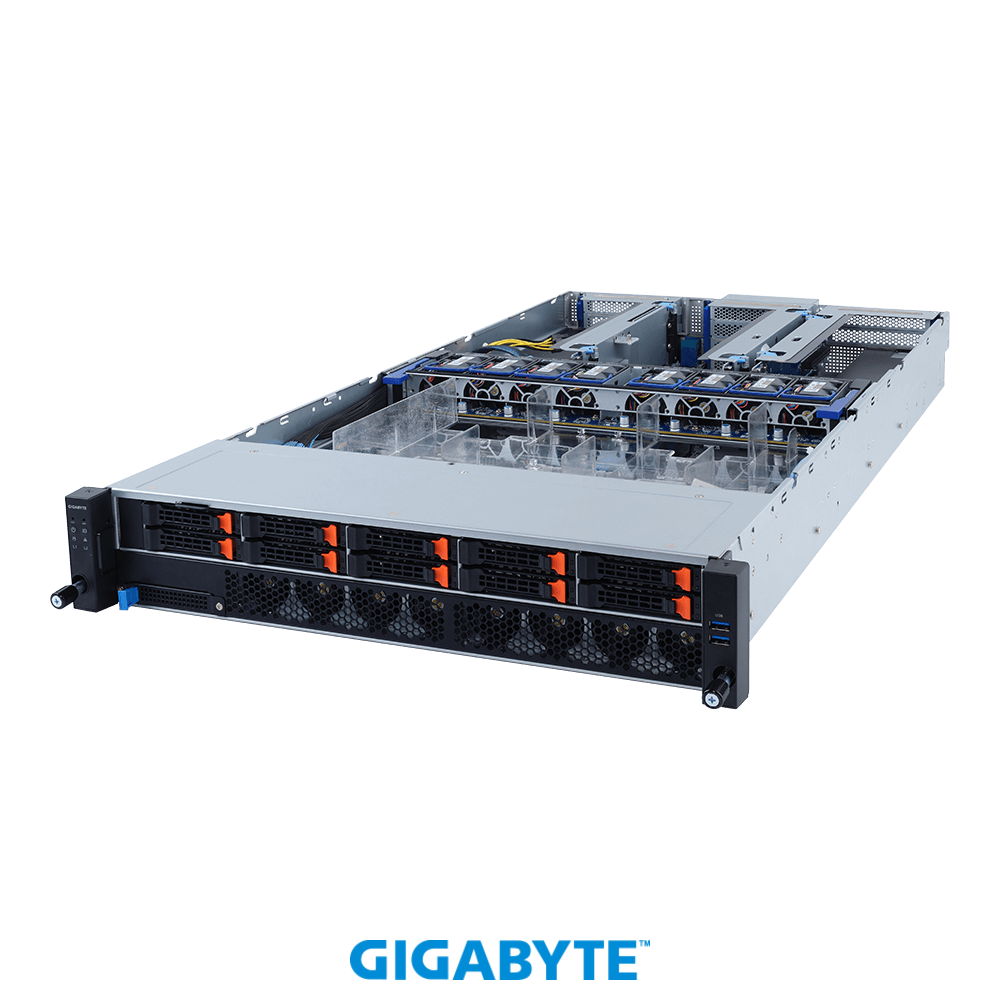
-a06f06fa5f3bd.png)
